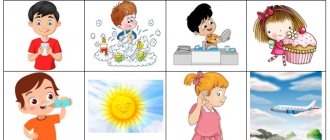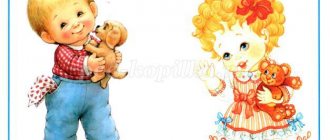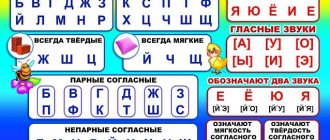Progress of the lesson
Organizing time.
Psychostudy “Smile”
All the children gathered in a circle, (speech therapist and children stand in a circle) I am your friend, and you are my friend! (the speech therapist points to himself, then to the children) Let’s hold hands tightly (hold hands) And smile at each other! (we smile at each other)
– The first to take his place will be the one who recognizes the sound from my lips: (A, O, U, A)
– What sounds did you name?
– What vowels do you still know?
– Collect cut-out pictures and you will find out what vowel sounds we will work with in class.
Pictures: (elephant, goat, ram, elk)
Main part of the lesson
1) Announcement of the topic of the lesson.
– Name the picture, highlight the vowel sounds.
– Which vowels are repeated? (A-O)
– Where can you meet all these animals together? ( In zoo)
– What do you think is the topic of our lesson?
– Today we will distinguish the vowel sounds O-A in syllables and words and sentences. And we'll take a short walk to the zoo. Slide No. 2
2) Analysis of the articulation of vowel sounds A-O
Slide No. 3
Working with mirrors
– Let’s compare the articulation of the sound A and O, how are they different and how are they similar?
A – The mouth is wide open, the tongue lies at the lower teeth. The diagram is a circle.
O – Lips are rounded and slightly extended forward. The diagram is an oval.
3) Breathing exercises.
– You found out that you were going to the zoo and were very happy, let’s show this through an exercise.
Inhale through the nose and exhale for a long time and pronounce the sound AAAAAA - joyfully
Inhale through the nose and exhale for a long time and pronounce the sound OOOOOO - scared
4) Development of phonemic awareness.
- Before we go to the zoo, let's check your attentiveness.
The game “Top-Clap” for the sound A - top with your foot, for the sound O - clap your hands.
A-O-AA-O-AM-MO-TO-OP-AS ELK, BOAR, ELEPHANT, RACCOON, BADGER
5) Development of phonemic analysis and synthesis.
- So, you have proven that you are very attentive. The animals have prepared a task for you: distribute them into two groups Slide No. 4
Exercise : distribute pictures of animals into two groups (GIRAFFE, FOX, BOAR, WOLF, ELEPHANT, RHINO, RRAM, ELK)
– Name the animals with the sound A – badger, fox, wild boar.
– Name the animals with the sound O – wolf, elephant.
– In the name of which animal do we hear the sounds O-A? (rhino).
6) Work on beeches O-A. Clarification of elements of lowercase letters a and o. Differentiation of these letters .
– You hear and distinguish sounds well. Can you recognize the letters well?
– Tell me, how do letters differ from sounds? (We see and write letters, and we hear and speak sounds).
– What elements does the lowercase letter O consist of? A? Slide No. 5
The teacher shows cards with uppercase and lowercase letters A and O.
(The letter O consists of one element - an oval. The letter A consists of two elements - an oval and an inclined line with a curve at the bottom to the right).
– What element do these letters have the same? (Oval).
– How are these letters different? (An inclined line with a curve at the bottom to the right. The letter O does not have it, but the letter A does).
7) Finger gymnastics
These are animals
Animals have four paws (we raise and lower 4 fingers on both hands). Claws can scratch (fingers move like claws). They don’t have a face, but a muzzle (connect the fingers of two hands, forming a ball, separate the fingers in turn, lowering them down). The tail, mustache and nose are wet (wave-like movements with the hand, “draw” a mustache, circular movements with the finger along the tip of the nose). And, of course, the ears (we rub the ears with our palms) Only on the top of the head (we massage two points on the crown).
 Corrective test. Working on individual cards .
Corrective test. Working on individual cards .
Circle the letter A in a square, O in a triangle
- Count how many letters a are in 1 line?
– Count how many letters o are in the second line?
9) Syllable analysis.
Game: “Locate the place of the animal” Slide No. 6
Animals offer you to find out who is behind whom, for this you need to divide the names of animals into syllables and determine the place of the sounds O-A (BOAR, WOLF, FOX, ELEPHANT, GIRAFFE)
The first animal in the name has 2 syllables and two vowels a. (boar)
After the wild boar there is an animal whose name has 1 syllable, the sound O is located after the sound B. (wolf)
The third is an animal whose name has 2 syllables, the sound A is after the sound C (fox)
After the fox there is an animal whose name has 1 syllable, the sound O stands between the sounds L, N (elephant).
Well, the last one is an animal whose name has 2 syllables, the sound a in the second syllable (giraffe).
- Well done boys. You most of the animals took their places, but not all. Rhino has prepared your next task.
Physical exercise. Ball game “Name the baby animals”
A lion has cubs, a tiger has a fox, a goat has a wolf, an elephant has cubs, etc.
10) Consolidation of the studied material.
Game "Magic Bag" - find the letter, name it and take it out of the bag.
Letters: (N, O, S, O, R, O, G)
– Collect a word from these letters. Slide No. 7
– Read the word and find the words that are hidden in this word.
– What two words does the word rhinoceros consist of?
– This word consists of two words: nose, horn, o – a connecting vowel. Such words are called compound words.
Vowel differentiation A-Z
Summary of speech therapy subgroup and individual lessons for children in grades 1-3 on the topic: “Differentiation of vowels A-Z” with violations of FFNR, FNR, ONR.
In my work, I often encounter the problem of softening sounds in students and poor differentiation between hard and soft consonants. Children cannot understand and correctly distinguish paronymic words that differ by one letter, such as rad-row, bear-mouse, etc. In their perception, these words sound the same. This is a gross violation of phonemic hearing, phonemic perception requires targeted correction.





